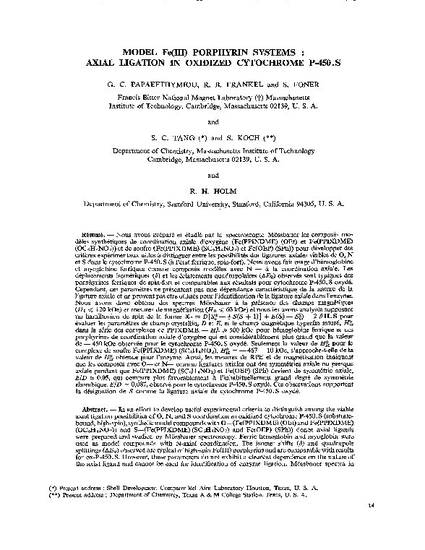
In an effort to develop useful experimental criteria to distinguish among the viable axial ligation possibilities of O, N, and S coordination in oxidized cytochrome P-450. S (substrate-bound, high-spin), syntheticmodel compounds with O-(Fe(PPIXDME) (OEt) and Fe(PPIXDME) (OC6H4NO2)) and S-(Fe(PPIXDME) (S6H4NO2) and Fe(OEP) (SPh)) donor axial ligands were prepared and studied by Mössbauer spectroscopy. Ferric hemoglobin and myoglobin were used as model compounds with N-axial coordination. The isomer shifts (δ) and quadrupole splittings (ΔEQ) observed are typical of high-spin Fe(III) porphyrins and are comparable with results for ox-P-450.S. However, these parameters do not exhibit a cleSarcut dependence on the nature of the axial ligand and cannot be used for identification of enzyme ligation. Mössbauer spectra in external magnetic fields (H0 ≤ 120 kOe) together with magnetization measurements (H0 ≤ 60kOe) were, therefore, obtained and analyzed assuming a spin-Hamiltonian, He = D[S2z - 1/3 S(S + 1] + E(S2x - S2y) + 2 β H.S, in order to obtain estimates of the crystal field parameters, D and E, and the saturation magnetic hyperfine field, H0hf, in the PPIXDME series. For ferric myoglobin and the oxygen-ligated porphyrins - H0hf ≥ 500 kOe, Considerably larger than the value of - 450 kOe observed for ox-P-450. S. Only in the thiolate complex Fe(PPIXDME) (SC6H4NO2) for which - H0hf = 476 ± 10 kOe is the enzyme value reasonably closely approached. In addition, magnetization and EPR measurements show that complexes with O- and N- donor ligands have axial or near axial symmetry while Fe(PPIXDME) (SC6H4NO2) and Fe(OEP) (SPh) show deviations from axial symmetry with E/D ≈ 0.05, which compares more favorably with the unusually large degree of rhombicity, E/D ≈ 0.087, observed for ox-P-450.S. These observations support the designation of cysteinate sulfur as the axial ligand in ox-P-450. S.
Available at: http://works.bepress.com/rfrankel/25/
